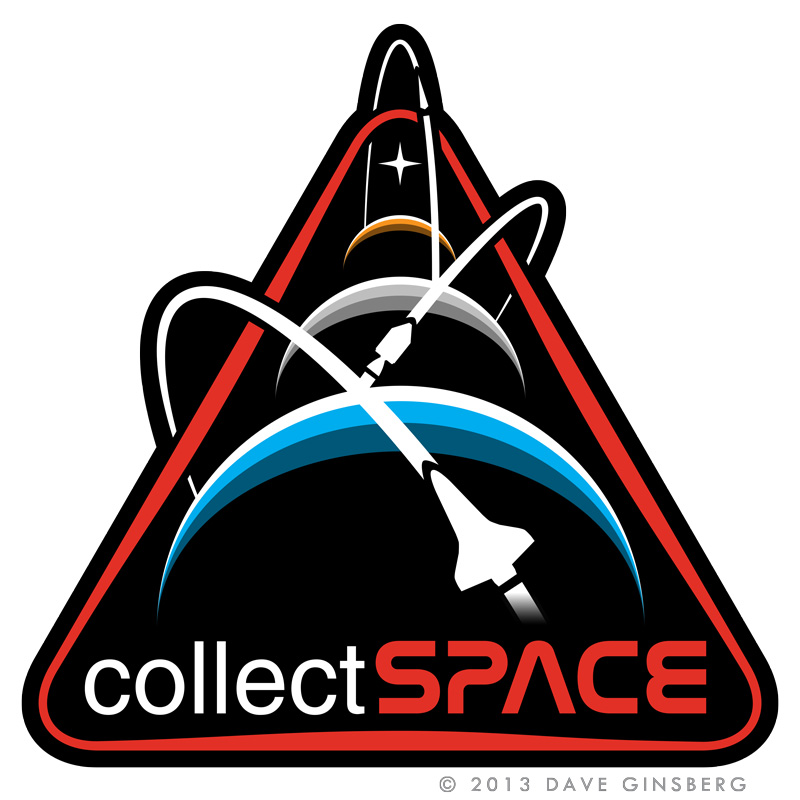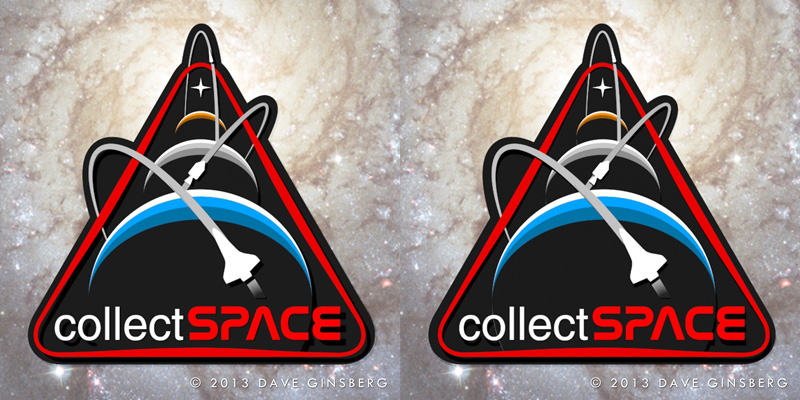collectSPACE Logo
2013
On the 44th anniversary of the Apollo 11 Moon landing, collectSPACE unveiled my patch design as their new brand identity. The design is used as their logo on collectspace.com and their Facebook and Twitter pages.
The design was the top choice for a patch for members of the collectSPACE community. Ideas and designs were submitted by collectSPACE members. In total, eight people entered sixteen designs including variants. Robert was so impressed with my design that he decided to adopt it not just as a patch, but as a new identifier for collectSPACE.
July 20th is also the "birthday" of collectSPACE, itself. Robert Pearlman, the creator of the space journalism web site, "the source for space history and artifacts", put it this way: "collectSPACE was 'born' on July 20, 1999, the 30th anniversary of the moon landing, and is a 'child' of the shuttle program."
The Design
The spacecraft depicted on the design reflect spaceflight history as well as collectSPACE's origins. The Space Shuttle Orbiter and the Apollo CSM make the connection to the beginnings of collectSPACE. The third spacecraft is a generic future spacecraft travelling to Mars and beyond.
The geometry worked out such that each orbital path "launches" from the point at which the previous orbit crosses its respective horizon. To me it symbolizes how each new advancement in our exploration of space jumps off the successes of earlier accomplishments as our reach continues to extend beyond each horizon. One collectSPACE member commented that the spheres are suggestive of the diverse collectSPACE community meeting and aligning while the orbital paths reflect artifacts and knowledge circulating among them. I thought that was a thoughtful insight since space collecting is characterized, in large part, by objects changing hands from one interested individual to another, passing along lessons of history in the process of preserving a legacy for future generations to enjoy.
I took inspiration from the emblems that Mike Okuda had created for the Constellation program. The design also recalls examples of space art I have seen that show the Earth, Moon, and Mars receding behind each other as a way to represent mankind's aspirations to explore our solar system and the sequential steps leading into the future of human spaceflight.
PAAAATCH INNNNN SPAAAAAACE!!!!
A collectSPACE patch was flown in space with astronaut Scott Kelly during his year-long mission on the International Space Station, from March 2015 to March 2016. While in orbit, Scott took this photo of the patch floating in the space station's Cupola, set against the Earth's horizon.
When I look at this image, I get chills seeing the brilliant blue and white curvature of the Earth framed behind the floating patch with its crescent Earth shimmering in the bright light. An added bit of artistic synchronicity is how the red window pane outlines match the border of the patch.
This is the third work of art I have had flown in space. The first was Spaceship Earth in 2006, and the second was my proposed design for a Space Shuttle program commemorative patch in 2010.

Alternate Design
I often create several design variations when working on a logo or patch. Sometimes it is simply to explore different approaches, and sometimes I get something in my head and I need to get it out. Such is the case with the design shown here.
One of my favorite NASA mission patches is that of the STS-134 Space Shuttle mission. That design depicts an atom with the electrons on orbits that break out of the central shape of the patch. With that patch in mind, I was inspired to create a version of my collectSPACE patch design that pushed the envelope ... and exceeded it.

illustrator
2013
Stereogram
I decided to take the design another extra step and try giving the viewer the sensation of 3D depth. The planets and orbits are supposed to appear as if they are receding into the image. I thought this might make a good subject for a stereogram. I took the two dimensional elements into 3ds max and modeled thickness and depth into the geometry. The result is a sort of 2D/3D hybrid. Viewing the two stereoscopic images by crossing the eyes until the images overlap gives the illusion of three dimensions.

illustrator
2013
View the stereoscopic images by crossing the eyes until the both overlap. This gives the illusion of three dimensions.






